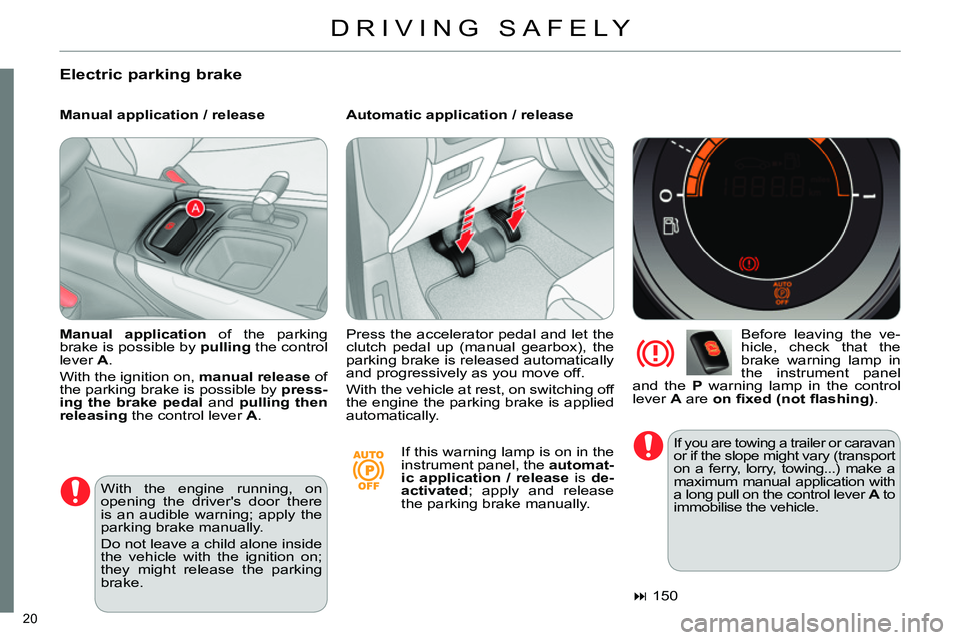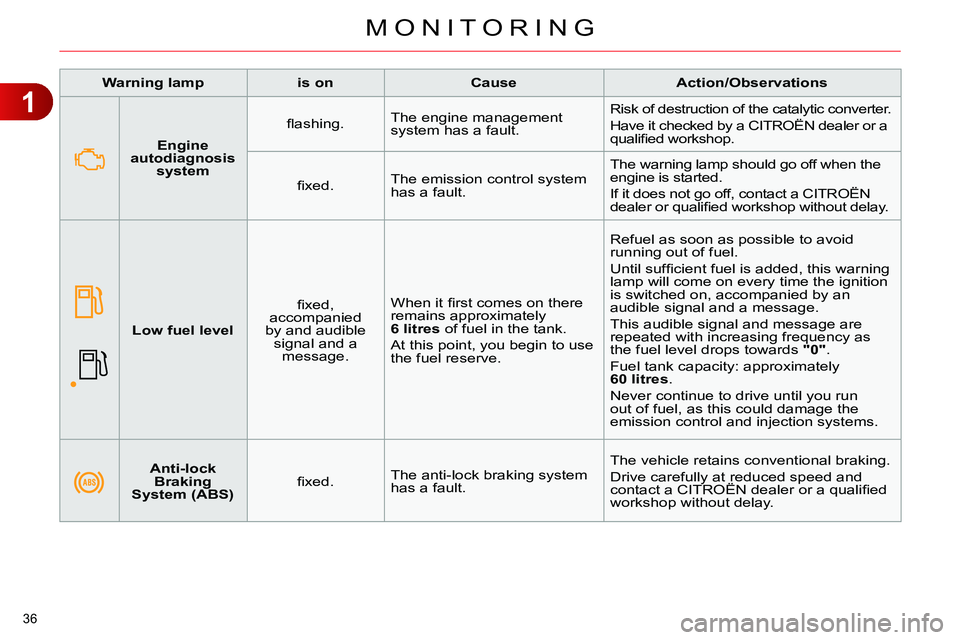2013 CITROEN C4 DAG check engine
[x] Cancel search: check enginePage 5 of 340

CONTENTS
3
Direction indicators 139
Hazard warning lamps 139
Horn 139
Braking assistance systems 140
Trajectory control systems (ESP) 141
Emergency or assistance call 142
Front seat belts 143
Airbags 146
8 - SAFETY 139 149
Electric parking brake 150
Manual parking brake 157
Manual gearbox 157
Electronic gearbox 158
Automatic gearbox 161
Hill start assist 164
Gear effi ciency indicator 165
Tyre under-infl ation detection 166
Stop & Start 168
Lane departure warning system 171
Blind spot sensors 172
Speed limiter 176
Cruise control 178
Parking space sensors 180
Parking sensors 182
9 - DRIVING 150 183
Bonnet 185
Running out of fuel (Diesel) 186
Petrol engines 187
Diesel engines 188
Checking levels 189
Checks 191
10 - CHECKS 184 192
Temporary puncture repair kit 193
Changing a wheel 198
Snow chains 202
Changing a bulb 203
Changing a fuse 209
12 V battery 213
Energy economy mode 216
Changing a wiper blade 216
Fitting roof bars 217
Very cold climate screen 217
Towing the vehicle 218
Towing a trailer 220
Audio pre-equipment 221
Accessories 222
11 - PRACTICAL
INFORMATION 193 223
Petrol engines 224
Petrol weights 225
Diesel engines 226
Diesel weights 227
Dimensions 230
Identifi cation markings 231
12 - TECHNICAL
DATA 224 232
Emergency or assistance 233
eMyWay 235
Audio system 289
AUDIO and
TELEMATICS 233 322
ALPHABETICAL
INDEX 327 331 VISUAL SEARCH 323 326
Page 22 of 340

20
DRIVING SAFELY
Electric parking brake
Manual application / release
Automatic application / release
Before leaving the ve-
hicle, check that the
brake warning lamp in
the instrument panel
and the P
warning lamp in the control
lever A
are on fi xed (not fl ashing)
.
Manual application
of the parking
brake is possible by pulling
the control
lever A
.
With the ignition on, manual release
of
the parking brake is possible by press-
ing the brake pedal
and pulling then
releasing
the control lever A
. Press the accelerator pedal and let the
clutch pedal up (manual gearbox), the
parking brake is released automatically
and progressively as you move off.
With the vehicle at rest, on switching off
the engine the parking brake is applied
automatically.
150
With the engine running, on
opening the driver's door there
is an audible warning; apply the
parking brake manually.
Do not leave a child alone inside
the vehicle with the ignition on;
they might release the parking
brake.
If you are towing a trailer or caravan or if the slope might vary (transport
on a ferry, lorry, towing...) make a
maximum manual application with
a long pull on the control lever A
to
immobilise the vehicle. If this warning lamp is on in the
instrument panel, the automat-
ic application / release
is de-
activated
; apply and release
the parking brake manually.
Page 29 of 340

27
Switch off the headlamps and front
foglamps when the level of light does
not require their use.
Avoid running the engine before moving
off, particularly in winter; your vehicle
will warm up much faster while driving.
As a passenger, if you avoid connecting
your multimedia devices (fi lm, music,
video game...), you will contribute to-
wards limiting the consumption of elec-
trical energy, and so of fuel.
Disconnect your portable devices be-
fore leaving the vehicle.
Limit the causes of excess
consumption
Spread loads throughout the vehicle;
place the heaviest items in the bottom
of the boot, as close as possible to the
rear seats.
Limit the loads carried in the vehicle
and reduce wind resistance (roof bars,
roof rack, bicycle carrier, trailer...). Use
a roof box in preference.
Remove roof bars and roof racks after
use.
At the end of winter, remove snow
tyres and refi t your summer tyres.
Observe the recommendations
on maintenance
Check the tyre pressures regularly,
when cold, referring to the label in the
door aperture, driver's side.
Carry out this check in particular:
- before a long journey,
- at each change of season,
- after a long period out of use.
Don't forget the spare wheel and the
tyres on any trailer or caravan.
Have your vehicle serviced regularly
(engine oil, oil fi lter, air fi lter...) and ob-
serve the schedule of operations rec-
ommended by the manufacturer.
When refuelling, do not continue after
the third cut-off of the nozzle to avoid
any overfl ow.
At the wheel of your new vehicle, it is only
after the fi rst 1 800 miles (3 000 kilometres)
that you will see the fuel consumption set-
tle down to a consistent average.
Page 35 of 340

1
MONITORING
33
Engine oil
pressure
fi xed. There is a fault with the
engine lubrication system. You must stop as soon it is safe to do so.
Park, switch off the ignition and contact a
CITROËN dealer or a qualifi ed workshop.
Warning lamp
is on
Cause
Action/Observations
Battery charge
fi xed. The battery charging circuit
has a fault (dirty or loose
terminals, slack or cut
alternator belt, ...). The warning lamp should go off when the
engine is started.
If it does not go off, contact a CITROËN
dealer or a qualifi ed workshop.
Braking
fi xed, associated
with the STOP
warning lamp. The braking system fl uid level
has dropped signifi cantly. You must stop as soon as it is safe to do so.
Top up with brake fl uid recommended by
CITROËN.
If the problem persists, have the system
checked by a CITROËN dealer or a
qualifi ed workshop.
+
fi xed, associated
with the electric
parking brake
malfunction
warning lamp,
if the parking
brake is released. The braking system has a
fault. You must stop as soon as it is safe to do so.
Park, switch off the ignition and contact a
CITROËN dealer or a qualifi ed workshop.
+
fi xed, associated
with the STOP
and ABS warning
lamps. The electronic brake force
distribution (EBFD) system
has a fault. You must stop as soon as it is safe to do so.
Have it checked by a CITROËN dealer or
a qualifi ed workshop.
Page 38 of 340

1
MONITORING
36
Warning lamp
is on
Cause
Action/Observations
Anti-lock
Braking
System (ABS)
fi xed. The anti-lock braking system
has a fault. The vehicle retains conventional braking.
Drive carefully at reduced speed and
contact a CITROËN dealer or a qualifi ed
workshop without delay.
Engine
autodiagnosis
system
fl ashing. The engine management
system has a fault. Risk of destruction of the catalytic converter.
Have it checked by a CITROËN dealer or a
qualifi ed workshop.
fi xed. The emission control system
has a fault. The warning lamp should go off when the
engine is started.
If it does not go off, contact a CITROËN
dealer or qualifi ed workshop without delay.
Low fuel level
fi xed,
accompanied
by and audible
signal and a
message. When it fi rst comes on there
remains approximately
6
litres
of fuel in the tank.
At this point, you begin to use
the fuel reserve. Refuel as soon as possible to avoid
running out of fuel.
Until suffi cient fuel is added, this warning
lamp will come on every time the ignition
is switched on, accompanied by an
audible signal and a message.
This audible signal and message are
repeated with increasing frequency as
the fuel level drops towards "0"
.
Fuel tank capacity: approximately
60 litres
.
Never continue to drive until you run
out of fuel, as this could damage the
emission control and injection systems.
Page 39 of 340

1
MONITORING
37
Warning lamp
is on
Cause
Action/Observations
Foot on the
clutch **
fi xed. In the STOP mode of Stop &
Start, changing to START
mode is refused because the
clutch pedal is not fully down. You must declutch fully to allow the
change to engine START mode.
**
Only on the two-tone instrument panel without audio system.
Dynamic
stability control
(ESP/ASR)
fl ashing. The ESP/ASR regulation is
active. The system optimises traction and
improves the directional stability of the
vehicle.
fi xed, associated
with illumination of
the indicator lamp
in the " ESP OFF
"
button, accompanied
by an audible signal
and a message.
The ESP/ASR or hill start
assist system has a fault. Have it checked by a CITROËN dealer or
a qualifi ed workshop.
Power steering
fi xed. The power steering has a
fault. Drive carefully at reduced speed.
Have it checked by a CITROËN dealer or
a qualifi ed workshop.
Under-infl ation
fi xed. The pressure in one or more
wheels is too low. Check the pressure of the tyres as soon
as possible.
This check should preferably be carried
out when the tyres are cold.
+
fl ashing
then fi xed,
accompanied
by the Service
warning lamp. The tyre pressure monitoring
system has a fault or no
sensor is detected on one of
the wheels. Under-infl ation detection is not assured.
Have the system checked by a CITROËN
dealer or a qualifi ed workshop.
Directional
headlamps
fl ashing. The directional headlamps
system has a fault. Have it checked by a CITROËN dealer or
a qualifi ed workshop.
Page 40 of 340

1
MONITORING
38
Water in Diesel
fi xed. The Diesel fuel fi lter contains
water. Risk of damage to the injection system
on Diesel engines.
Contact a CITROËN dealer or a qualifi ed
workshop without delay.
Particle
emissions fi lter
(Diesel)
fi xed,
accompanied by
an audible signal
message on the
risk of blockage
of the particle
emissions fi lter. This indicates that the particle
emissions fi lter is starting to
become saturated. As soon as driving conditions allow,
regenerate the fi lter by driving at a speed
of at least 35 mph (60 km/h) until the
warning lamp goes off.
fi xed, accompanied
by an audible
signal and and a
message that the
particle emissions
fi lter additive level
is too low. This indicates the low level of
the additive reservoir. Have the reservoir topped up as soon
as possible by a CITROËN dealer or a
qualifi ed workshop.
Warning lamp
is on
Cause
Action/Observations
Airbags
temporarily. This lamp comes on for a few
seconds when you turn on the
ignition, then goes off. This lamp should go off when the engine
is started.
If it does not go off, contact a CITROËN
dealer or a qualifi ed workshop.
fi xed. One of the airbag or seat belt
pretensioner systems has a
fault. Have it checked by a CITROËN dealer or
a qualifi ed workshop.
Page 45 of 340

1
MONITORING
43
Engine oil level indicator
The vehicle must be on level
ground and the engine must
have been off for more than
30 minutes for this level check to
be accurate.
Oil level correct
This is indicated by the fl ashing of
"OIL"
or the display of a specifi c mes-
sage in the instrument panel, coupled
with the service warning lamp and ac-
companied by an audible signal.
If the low oil level is confi rmed by a
check using the dipstick, the level must
be topped up to avoid damage to the
engine.
Oil level indicator error
Dipstick
Refer to the "Checks" section to locate
the dipstick and the oil fi ller cap on your
engine.
Oil level incorrect This is indicated by the fl ashing of
"OIL--"
or the display of a specifi c mes-
sage in the instrument panel. Contact a
CITROËN or a qualifi ed workshop.
There are 2 marks on the
dipstick:
- A
= max; never exceed
this level (risk of dam-
age to the engine),
- B
= min; top up the level
via the oil fi ller cap, us-
ing the correct grade of
oil for your engine.
This information is displayed for a few
seconds when the ignition is switched
on, at the same time as the service in-
formation.